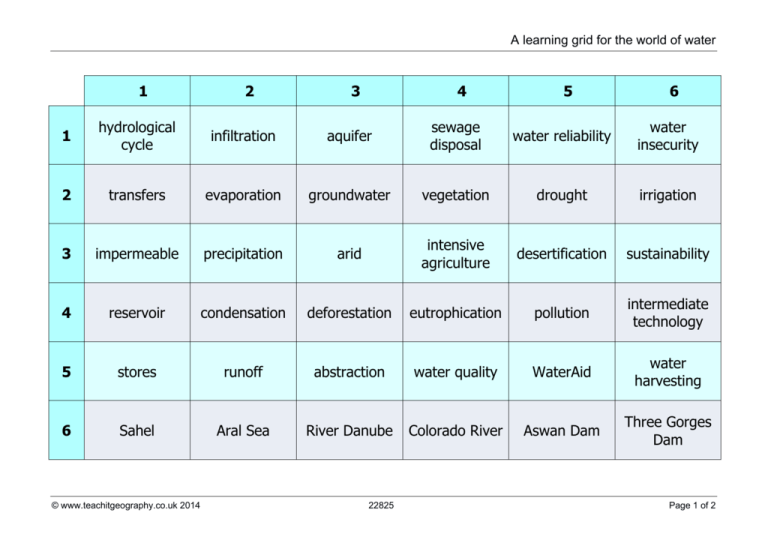1 2 3 4 5 6 1 hydrological cycle infiltration aquifer sewage disposal
advertisement

A learning grid for the world of water 1 2 3 4 5 6 1 hydrological cycle infiltration aquifer sewage disposal water reliability water insecurity 2 transfers evaporation groundwater vegetation drought irrigation 3 impermeable precipitation arid intensive agriculture desertification sustainability 4 reservoir condensation deforestation eutrophication pollution intermediate technology 5 stores runoff abstraction water quality WaterAid water harvesting 6 Sahel Aral Sea River Danube Colorado River Aswan Dam Three Gorges Dam © www.teachitgeography.co.uk 2014 22825 Page 1 of 2 A learning grid for the world of water Teaching notes Learning grids can be used in a variety of ways. 1. Students will need a die. They roll the die twice to obtain a pair of numbered coordinates. This will identify a cell on the learning grid. They need to write down the word or phrase from that cell. Repeating this three or four times will provide the student with a collection of words and/or phrases. The student is then asked to include all words and/or phrases in a sentence or piece of extended writing. 2. The student can be asked to write a piece of extended writing using a minimum of twelve words and/or phrases from the learning grid. The words and/or phrases can be chosen by the teacher, by the class or by the student. 3. The grid can be used as the basis for a bingo game in class. The student highlights six words and/or phrases and ‘crosses’ these off as the teacher gives the definition of the word and/or phrase. An alternative could be to ask students for the definitions. 4. Students could play battleships in pairs against each other. Both students ‘hide’ five submarines – each occupies a single cell on the learning grid. The first student challenges the second student with a coordinate to identify a cell but must also give a definition of the word and/or phrase in the cell. 5. The class could be asked to provide a definition for each cell in the learning grid. These are added to a blank version of the learning grid and the 36 definitions have to be matched to the 36 words and phrases. A simple interactive version is also available for this resource. 6. Each student could be provided with a copy of the learning grid and asked to colour the cells based on their comprehension of the words and phrases. A traffic lights scheme can be used with red indicating a lack of knowledge, orange indicating some understanding and green indicating full comprehension. 7. Each student could be provided with an A4 copy of the learning grid and asked to annotate it with relevant examples/case studies etc. 8. Students could use the learning grid as a revision checklist. © www.teachitgeography.co.uk 2014 22825 Page 2 of 2 A learning grid for the world of water 1 2 3 4 5 6 1 hydrological cycle infiltration aquifer sewage disposal water reliability water insecurity 2 transfers evaporation groundwater vegetation drought irrigation 3 impermeable precipitation arid intensive agriculture desertification sustainability 4 reservoir condensation deforestation eutrophication pollution intermediate technology 5 stores runoff abstraction water quality WaterAid water harvesting 6 Sahel Aral Sea River Danube Colorado River Aswan Dam Three Gorges Dam © www.teachitgeography.co.uk 2014 22825 © www.teachitgeography.co.uk 2014 1 22825 1






